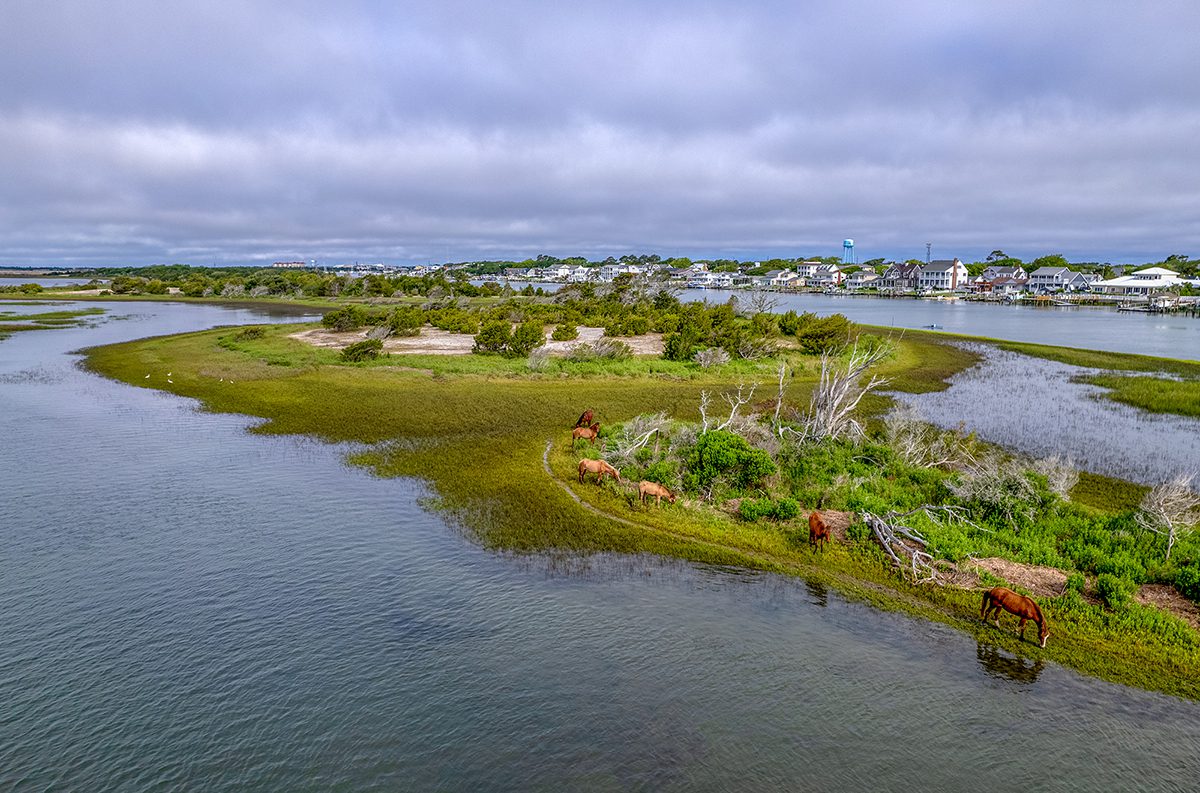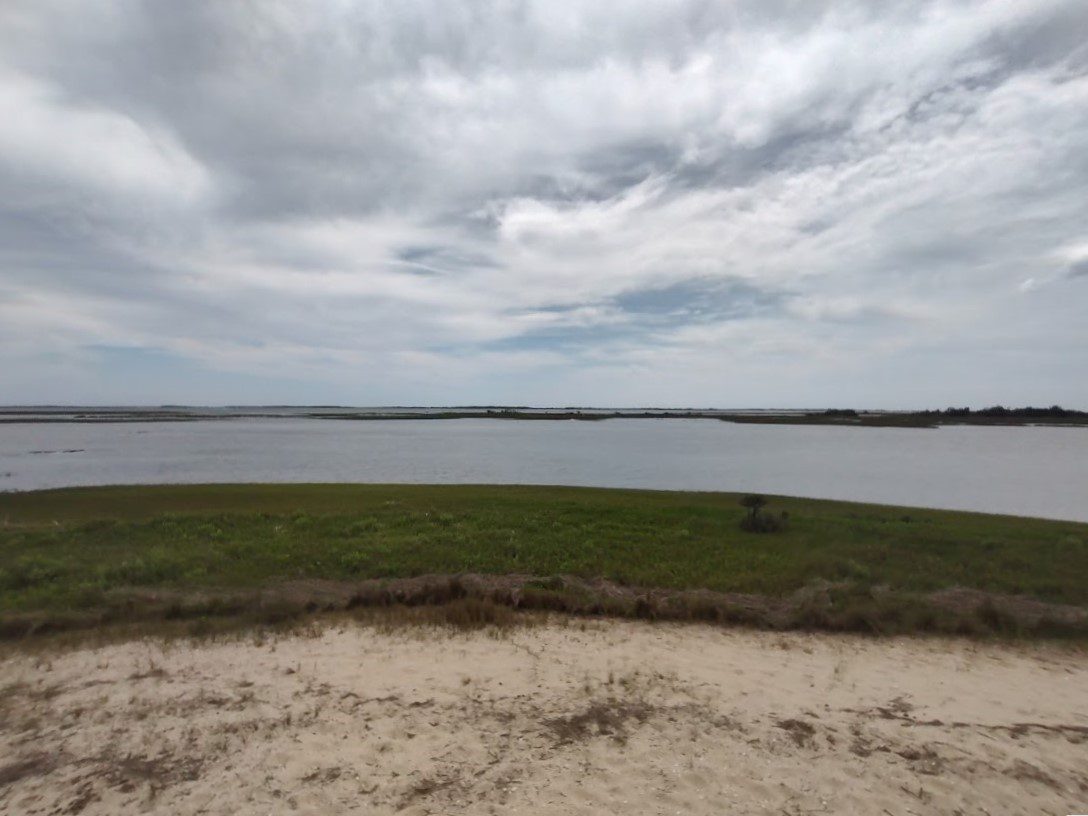
This special news feature is part of Coastal Review’s 12-month observance of the Coastal Area Management Act’s 50th year.
BEAUFORT – The state’s Rachel Carson Reserve protects more than its herd of around 30 wild horses.
Supporter Spotlight
The dedicated nature preserve’s five uninhabited barrier islands, totaling 2,315 acres, protect historic downtown Beaufort from the ravages of ocean winds and tides.
“You can see just how vulnerable the town of Beaufort can be during storms coming through that Beaufort Inlet,” Central Sites Manager Paula Gillikin said early Friday afternoon from the boardwalk on Carrot Island, one of the five islands making up the site.
Gillikin was speaking to North Carolina Department of Environmental Quality leadership, local, state and federal elected officials, fiscal research and governor’s office budget staff, partners, residents and volunteers, as part of a “Discover the N.C. Coastal Reserve Tour.”
The gathering of about 20 had met earlier that morning at Beaufort Hotel to tour the Rachel Carson Reserve. It was the third stop on a multi-year campaign launched in June 2023 when the Currituck Banks Reserve reopened after repairs. The second stop was at Bird Island Reserve in December 2023.
NCDEQ Chief Deputy Secretary Tim Watkins explained before the tour how 50 years ago, “North Carolina enacted the Coastal Area Management Act, or CAMA, as we all know it.”
Supporter Spotlight
“Passing CAMA in 1974 was a bold and important step that was intended to balance economic development and protection of coastal resources through coordination and planning under the umbrella of state and local partnership,” Watkins said. “CAMA was also intended to reflect the will of coastal residents in finding this balance.”
He noted how CAMA was amended in the 1980s to establish the state Coastal Reserve Program, which “provides public access to coastal areas, essential habitat, fisheries and wildlife, and a cleaner healthier environment for all. The reserve sites also strengthen our communities by developing a sense of place and creating opportunities to reconnect and recharge with our natural world.”

Coastal Reserve Program Manager Rebecca Ellin said that the reserve program protects more than 44,000 acres of coastal and estuarine habitats across the 10 sites.
These sites provide essential habitat for wildlife, educational opportunities for students, teachers and the public, living laboratories for scientists to inform the management of the state’s coasts and estuaries, public enjoyment for citizens and visitors and protection of local communities from storms and erosion, Ellin said.
“The reserve program in North Carolina started nearly 40 years ago with the designation of the North Carolina National Estuarine Research Reserve. This happened in 1985 via a state-federal partnership between the National Oceanic and Atmospheric Administration National Estuarine Research Reserve System and the Division of Coastal Management,” she said.
The designation of the North Carolina National Estuarine Research Reserve provided an inspirational model for the state of North Carolina to protect additional habitat areas, Ellin continued.
“In 1989, the General Assembly amended the Coastal Area Management Act to do just that and formally established the North Carolina Coastal Reserve, which includes the North Carolina National Estuarine Research Reserve.”
There were a handful of past and current elected officials on hand, including Rett Newton, who was raised in Beaufort and is a former town mayor. He said that protecting the Rachel Carson Reserve is “personal for us. It is personal. It may not be personal for Raleigh, Durham, Chapel Hill, or Washington, D.C., but I assure you it is very personal for us.”
Beaufort Mayor Sharon Harker, who is in her second term, added that the reserve has a lot of talents, and the town is working with the state programs to protect the island for future generations. “It’s a classroom, it’s a laboratory, it provides us information so that we can inform policies to be better and proactive caretakers of the island, but the reserve is a gem. It’s part of our character, it’s part of our history.”
Sen. Norm Sanderson, R-Pamlico, who also represents Carteret County, told attendees that the reserve is worth fighting for and worth protecting, “not only for its beauty, but its protection” as a barrier island. “It’s up to us to save it for the next generation.”
Rep. Pricey Harrison, D-Guilford, was on the coast for the tour, as well. A resident of Greensboro, Harrison said she spends her weekends patrolling the shoreline of the Rachel Carson Reserve and has for 34 years.
She extended her gratitude to those who have made the reserve “such a special place” adding, “I love this place. I’m going to do what I can save it.”
Rep. Celeste C. Cairns, R-Carteret and Craven counties, spoke briefly, stating she is “so proud of this district. It’s impossible to express how much I love it here.”

Gillikin, who grew up in Beaufort and is currently a town commissioner, has been with the reserve program since 2007, and oversees both the Rachel Carson Reserve and Permuda Island Reserve near Topsail Island.
Gillikin said she feels “privileged to coordinate the stewardship of this site and to work with all the passionate community members and commercial users and teachers and advisory committee members. It really is all about people.”
She echoed Newton in that the site is very personal to her, because five generations back, her family owned a lot of the land, and “I never thought that I would come back to Beaufort and be a steward of the land.” She left Beaufort to attend the University of North Carolina Wilmington.
“Their blood, sweat and tears are out there. And mine are too,” she said, clarifying “no big injuries, just some nicks and cuts.”
After the tour, Ellin expressed her gratitude for those who joined, “to celebrate the Rachel Carson Reserve, share their perspectives, and take in its beauty and the diverse roles the reserve plays for ecosystems and people alike.”
About the Carrot Island Living Shoreline Project
Part of the event included a quick peek by boat of the Carrot Island Living Shoreline Project, currently under construction.
A representative of consulting firm Moffatt & Nichol, which is a contractor on the living shoreline project here, told Coastal Review Monday that work began April 12. A joint project between Carteret County and the North Carolina Coastal Reserve, the work includes around 1,475 linear feet of living shoreline, extending along the east side of Carrot Island, which is adjacent to Taylor’s Creek.
The design features two sills. There is a sill of wave-attenuation units, called ExoForms and manufactured by Natrx, a nature-based resilience and restoration company in Raleigh, and a sill with oyster habitat units called Oyster Catchers, which are manufactured by Sandbar Oyster Co. in Beaufort.
The footprint for the ExoForms is around 11,250 square feet, with a length of 1,250 feet, and the footprint for the oyster habitat sill is about 6,960 square feet, and about 1,270 linear feet.
The sills run parallel to one another with a gap of 10 feet in between. Both are 100-foot segments with 10-foot gaps between the segments to allow water and wildlife to move through.

Plans include planting marsh grass, both Spartina alterniflora and Spartina patens, to support stabilization of the shoreline and enhance the ecological value of the project, according to the company.
“The length of shoreline to be protected was chosen to provide maximum benefit to the Carrot Island shoreline based upon available funding from the National Fish and Wildlife Foundation, the North Carolina Land and Water Fund, and the North Carolina Department of Environmental Quality,” according to the company.
Gilikin said monitoring the project’s performance over time and sharing successes and lessons learned could inform future living shoreline design and estuarine shoreline management in coastal North Carolina.
About the reserve program
The North Carolina Coastal Reserve and National Estuarine Research Reserve program initiative began in 1982 with funding from the National Oceanic and Atmospheric Administration’s National Estuarine Research Reserve System.
Three sites were dedicated in 1985 to be part of the North Carolina National Estuarine Research Reserve: Rachel Carson, Currituck Banks and the Zeke Island reserves. The fourth national site, Masonboro Inlet Reserve, was designated in 1991.
The state initiated the parallel program in 1987. This move, according to NCDEQ, was to protect other coastal areas that could not be incorporated into the national program. The state acquired Permuda Island near topsail Island that year and Buxton Woods in the southern Outer Banks in 1988.
In 1989 CAMA formally established the North Carolina Coastal Reserve Program. In the following years, the state program grew to include Kitty Hawk Woods Reserve in 1992, Bald Head Woods Reserve in 1993, Emily and Richardson Preyer Buckridge Reserve in Tyrrell County in 1999, and Bird Island Reserve, the southernmost site, in 2002.








